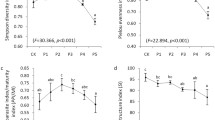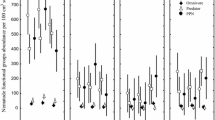Abstract
Soil nematode, rotifer, and tardigrade populations were sampled in field plots of native northern mixed prairie in southeastern Montana from 1977 to 1979. The field plots were exposed to season-long fumigation with controlled low-levels of SO2 throughout the growing seasons (April–October). Two field sites were used, one fumigated for five seasons (1975–1979) and the other for four (1976–1979). Seasonal average SO2 concentrations ranged from control (< 1 pphm) to approximately 7 pphm. Soil fauna were sampled by taking soil cores and extracting them by the Baermann wet funnel technique. Total counts were made for tardigrades and rotifers while nematodes were divided into three groups-stylet bearers (Tylenchida-Dorylimida), non-stylet bearers, and the predatory Mononchida. Consistent trends of substantial reductions in tardigrade populations occurred in all treated plots in all years; however, statistical significance was achieved only in 1979 when sample size and individual core size were substantially increased. Tardigrades were found to be restricted almost completely to the surface two centimeters of the soil profile. Significant population reductions in the treated plots of both sites were found for non-stylet bearing nematodes in 1977 only. Stylet bearing types and predaceus Mononchida appeared unaffected by the SO2 as were the soil rotifers, although slight but consistent trends of reduction in rotifers occurred in the highest treatments in 1977 and 1978. Both nematodes and rotifers were distributed primarily in the 0 to 10 cm layer of the soil profile but not restricted to the soil surface as much as the tardigrades. Implications of the responses to SO2 and vertical distributions of the three groups are discussed.
Similar content being viewed by others
References
Abrahamsen, G., Hovland, T., and Hagvar, S.: 1978, ‘Effects of Artificial Acid Rain and Liming on Soil Organisms and the Decomposition of Organic Matter’, SNSF-contribution FA 28/78, p. 23.
Bååth, E., Berg, B., Lohm, U., Lundgren, B., Lundkvist, H., Rosswall, T., Söderström, and Wiren, A: 1981, ‘Effects of Experimental Acidification and Liming on Soil Organisms and Decomposition in a Scots Pine Forest’, Pedobiologia (in press).
Babich, H. and Stotsky, G.: 1974, Crit. Rev. Environ. Control 4, 353.
Bryant, R. D., Gordy, E. A., and Laishley, E. J.: 1979, Water, Air, and Soil Pollut. 11, 437.
Dodd, J. L. and Lauenroth, W. K.: 1980, Water, Air, and Soil Pollut. 15, 257.
Dodd, J. L., Lauenroth, W. K., and Heitschmidt, R. K.: 1980, ‘Effects of Controlled SO2 Exposure on Net Primary Production and Plant Biomass Dynamics’, in Preston, E. M. and Gullett, T. L. (eds.), The Bioenvironmental Impact of a Coal-Fired Power Plant, Fifth Interim Report, EPA 600/13-80-052, Corvallis Environmental Research Laboratory, Corvallis, Oregon.
Durran, D. R., Meldgin, M. J., and Liv, M. K.: 1979, Atmos. Environ. 13, 1021.
Franz, H.: 1941, Forschungsdienst 11, 355.
Franz, H.: 1950, ‘Etat de nos connaissances sur la microfaune du sol’, Ecologic (Colloques int. cent. natn. Rech. scient.), Paris 1950, p. 81–92.
Grant, I. F., Bancroft, K., and Alexander, M.: 1979, Microbial Ecology 5, 85.
Hallas, T. E. and Yeates, G. W.: 1972 Pedobiologia 12, 28.
Hocking, D. and Hocking, M. B.: 1977, Environ. Pollut. 13, 57.
Lee, J. J., Preston, E. M., and Weber, D. B.: 1978, ‘Temporal Variation in SO2 Concentrations on ZAPS’, in Preston, E. M. and Gullett, T. L. (eds.), The Bioenvironmental Impact of a Coal-Fired Power Plant, Fourth Interim Report, EPA 600/13-79-044, U.S. Environmental Protection Agency, Corvallis, Oregon, p. 284–305.
Lee, J. J. and Lewis, R. A.: 1978, ‘Zonal Air Pollution System: Design and Performance’, in Preston, E. M. and Lewis, R. A. (eds.), The Bioenvironmental Impact of a Coal-Fired Power Plant, Third Interim Report, Colstrip, Montana. EPA 600/3-78-021, Corvallis, Oregon.
Lewis, R. A., Lefohn, A. S., and Glass, N. R.: 1976, ‘Introduction to the Colstrip, Montana, Coal-Fired Power Plant Project’, in Lewis, R. A., Lefohn, A. S., and Glass, N. R. (eds.), The Bioenvironmental Impact of a Coal-Fired Power Plant, Second Interim Report, Colstrip, Montana. June, 1975, EPA 600/3-76-013, p. 1–12.
Preston, E. M. and Gullett, T. L.: 1978, ‘Spatial Variation of Sulfur Dioxide Concentrations on ZAPS during the 1977 Field Season’, in Preston, E. M. and Gullett, T. L. (eds.), The Bioenvironmental Impact of a Coal-Fired Power Plant, Fourth Interim Report, EPA 600/13-79-044, U.S. Environmental Protection Agency, Corvallis, Oregon, p. 306–330.
Ramazzotti, G.: 1959, Atti. Soc. Ital. Sci. Nat. 98, 199.
Riggin, G. T., Jr.: 1962, Va. Agric. Exp. Stn. Tech. Bull. 152, p. 145.
Saunders, P. J. W.: 1966, Ann. Appl. Biol. 1, 103.
Snedecor, G. W. and Cochran, W. G.: 1967, Statistical Methods. Iowa State Univ. Press, Ames.
Wallwork, J. A.: 1976, The Distribution and Diversity of Soil Fauna, Academic Press, New York, p. 355.
Yeates, G. W.: 1979, J. Nematology 11, 213.
Author information
Authors and Affiliations
Rights and permissions
About this article
Cite this article
Leetham, J.W., McNary, T.J., Dodd, J.L. et al. Response of soil nematodes, rotifers and tardigrades to three levels of season-long sulfur dioxide exposures. Water Air Soil Pollut 17, 343–356 (1982). https://doi.org/10.1007/BF00460102
Received:
Revised:
Issue Date:
DOI: https://doi.org/10.1007/BF00460102




